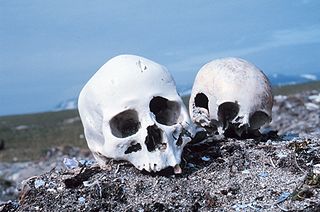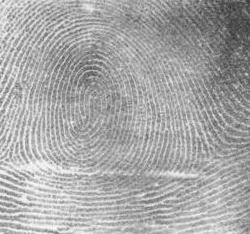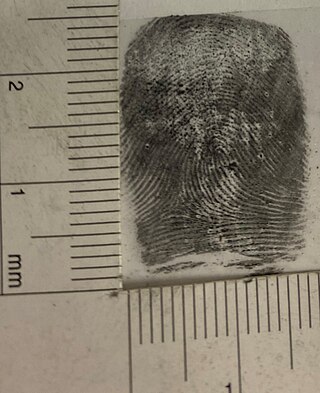Related Research Articles

Forensic science, also known as criminalistics, is the application of science to criminal and civil laws, mainly—on the criminal side—during criminal investigation, as governed by the legal standards of admissible evidence and criminal procedure. Forensic Science is a broad field including a multitude of practices like DNA analysis, fingerprint analysis, blood stain pattern analysis, firearms examination and ballistics, tool mark analysis, serology, toxicology, hair and fiber analysis, entomology, questioned documents, anthropology, odontology, pathology, epidemiology, footwear and tire tread analysis, drug chemistry, paint and glass analysis, digital audio video and photo analysis.

A fingerprint is an impression left by the friction ridges of a human finger. The recovery of partial fingerprints from a crime scene is an important method of forensic science. Moisture and grease on a finger result in fingerprints on surfaces such as glass or metal. Deliberate impressions of entire fingerprints can be obtained by ink or other substances transferred from the peaks of friction ridges on the skin to a smooth surface such as paper. Fingerprint records normally contain impressions from the pad on the last joint of fingers and thumbs, though fingerprint cards also typically record portions of lower joint areas of the fingers.

Qualitative research is a type of research that aims to gather and analyse non-numerical (descriptive) data in order to gain an understanding of individuals' social reality, including understanding their attitudes, beliefs, and motivation. This type of research typically involves in-depth interviews, focus groups, or observations in order to collect data that is rich in detail and context. Qualitative research is often used to explore complex phenomena or to gain insight into people's experiences and perspectives on a particular topic. It is particularly useful when researchers want to understand the meaning that people attach to their experiences or when they want to uncover the underlying reasons for people's behavior. Qualitative methods include ethnography, grounded theory, discourse analysis, and interpretative phenomenological analysis. Qualitative research methods have been used in sociology, anthropology, political science, psychology, social work, folklore, educational research and software engineering research.
Educational research refers to the systematic collection and analysis of data related to the field of education. Research may involve a variety of methods and various aspects of education including student learning, interaction, teaching methods, teacher training, and classroom dynamics.

In forensic science, questioned document examination (QDE) is the examination of documents potentially disputed in a court of law. Its primary purpose is to provide evidence about a suspicious or questionable document using scientific processes and methods. Evidence might include alterations, the chain of possession, damage to the document, forgery, origin, authenticity, or other questions that come up when a document is challenged in court.
Forensic identification is the application of forensic science, or "forensics", and technology to identify specific objects from the trace evidence they leave, often at a crime scene or the scene of an accident. Forensic means "for the courts".

Francisca Rojas is believed to be the first criminal found guilty through fingerprint evidence in the world.
The International Association for Identification (IAI) is the largest forensic organization in the world. It was originally formed as the "International Association for Criminal Identification" in October 1915. Through the years it has grown into an educational and certification body with over 6,000 members worldwide.

Dr. Edmond Locard was a French criminologist, the pioneer in forensic science who became known as the "Sherlock Holmes of France". He formulated the basic principle of forensic science: "Every contact leaves a trace". This became known as Locard's exchange principle.

Fingerprint powders are fine powders used, in conjunction with fingerprint brushes, by crime scene investigators and other law enforcement personnel to search for and enhance latent/invisible fingerprints that can be used to determine identification. This method of fingerprint development commonly referred to as dusting for fingerprints, involves the adherence of the powder particles to the moisture and sweat secretions deposited on to surfaces by the raised ridges on fingers, palms, or soles of feet designed for grip, called friction ridges.
The following outline is provided as an overview of and topical guide to forensic science:

The Canadian Identification Society (CIS) is a bilingual professional non-for-profit fellowship of police officers and civilian members who share interests and employment in crime scene investigation. Also known in French as Société Canadienne de l'Identité (SCI)
Carole Elisabeth Chaski is a forensic linguist who is considered one of the leading experts in the field. Her research has led to improvements in the methodology and reliability of stylometric analysis and inspired further research on the use of this approach for authorship identification. Her contributions have served as expert testimony in several federal and state court cases in the United States and Canada. She is president of ALIAS Technology and executive director of the Institute for Linguistic Evidence, a non-profit research organization devoted to linguistic evidence.

Alexandre Beaudoin is a Quebec fingerprint scientist known for inventing a technique for developing latent fingerprints on dry and/or wet porous surfaces.
Brian E. Dalrymple is an Ontarian fingerprint scientist known for introducing for the first time the use of lasers as a forensic light sources for fingerprints and other evidence detection, using the Argon Ion Lasers to detect the inherent fluorescence of the latent fingerprints and finding fluorescing evidence. That was the beginning of a real revolution in the forensic identification field. Brian Dalrymple also become the first to use this forensic technique on a real case.

Forensic Podiatry is a subdiscipline of forensic science in which specialized podiatric knowledge including foot and lower limb anatomy, musculoskeletal function, deformities and diseases of the foot, ankle, lower extremities, and at times, the entire human body is used in the examination of foot-related evidence in the context of a criminal investigation. Forensic Podiatry has been defined as:
The application of sound and researched podiatry knowledge and experience in forensic investigations, to show the association of an individual with a scene of crime, or to answer any other legal question concerned with the foot or footwear that requires knowledge of the functioning foot.
Ashbaugh is a surname. Notable people with the surname include:

Glove prints, also sometimes described as gloveprints or glove marks, are latent, fingerprint-like impressions that are transferred to a surface or object by an individual who is wearing gloves.
Pierre Margot is a Swiss forensics scientist known for his contribution to the invention of the first forensic light source Polilight for the detection of fingerprint, biological fluids and other evidence on the crime scene. This new technology was named by the Powerhouse Museum as one of the top 100 Australian innovations of the 20th century. It was a great revolution in the field of forensic identification since this light could be used at the crime scene, unlike lasers at that time.
Inez Whipple Wilder, born Inez Luanne Whipple, was an American herpetologist and anatomist, affiliated with Smith College from 1902 until her death. She made notable contributions to the study of fingerprints and the biology of salamanders.
References
- 1 2 "Ashbaugh, David Robinson | Encyclopedia.com".
- 1 2 Ashbaugh, DR. Quantitative-Qualitative Friction Ridge Analysis: An Introduction to Basic and Advanced Ridgeology, CRC Press, 1999
- ↑ Ashbaugh, DR. Ridgeology : Our next evaluative step, RCMP Gazette, 45(3), 1983
- ↑ Triplett M, Fingerprint Dictionary, Two Rings Publishing, Bellevue, Washington